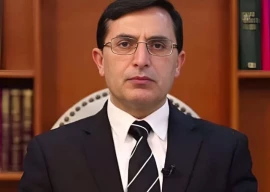
Speaking at the sixth workshop on ‘Defence, Deterrence and Stability in South Asia’, jointly organised by the Islamabad-based Centre for International Strategic Studies (CISS) and the International Institute for Strategic Studies (IISS) London.
India admits ceasefire violations under 'Operation Arjun'
The workshop, attended by diplomats, academics and analysts of strategic issues, deliberated on regional issues, including Pakistan’s relations with US and India, security in Indian and Pacific oceans region and shifts and trends in nuclear doctrine and deterrence.
“Because of mutually assured destruction there is unlikelihood of a hot war or a conventional war and therefore the conflict has shifted towards sub-conventional level. As of now, that could be seen in full play at our Western borders,” Kidwai said.
He recalled the public pronouncements by Indian leadership of using terrorism to destabilise Pakistan. “An announced sub-conventional direction has been taken by India,” he said, adding that the region is now entering a “cold war era for regional supremacy … creation of proxies.”
Kidwai credited the reduction in chances of convention war to Pakistan’s “robust nuclear capability” and the policy of ‘Full Spectrum Deterrence’.
“The era of conventional hot wars is behind us. India can generate as much heat as it likes on Line of Control, including phantom surgical strikes from time to time, which in any case would be strongly retaliated by Pakistan and that’s about it,” he said.
He also explained the salient features of the ‘Full Spectrum Deterrence’ policy, which envisages possession of a full range of nuclear weapons that could reach every part of the Indian territory; having enough yield and numbers to deter rival from its policy of massive retaliation; and having liberty of picking targets, including counter-value, counter-force and battlefield.
Speaking about Pakistan’s nuclear capabilities, he said, the country is self-reliant in the nuclear field, but its programme is not the fastest growing in the world.
“There are no aggressive overtones to our capability; the over-arching policy is ‘Full Spectrum Deterrence’, but within the larger philosophy of Credible Minimum Deterrence,” he said.
He added that Pakistan would maintain peace and security in South Asia “with adequate level of armaments at all tiers: strategic, operational and tactical”.
The NCA adviser renewed the call for resolution of disputes in the region, saying as long as that is not done, the region would remain in flux, alternating between “strategic stability and instability”.
Fragile peace in the meantime, he believed, would be maintained through defence and deterrence postures.
Emphasising that Pakistan made the right choices, while tackling threats to its security, he said, “Pakistan will find itself on the right side of the history; the coming decades are likely to validate this.”
Kashmir Issue: Resolution against Indian aggression
On the occasion, IISS team leader Desmond Bowen spoke about the difference in understanding of deterrence in the West and South Asia. He also underlined the risks associated with the nuclear capability.
“Security of Pakistan is a sovereign responsibility and so is the calculation of risk in these matters. How manageable are those risks now, but above all in times of crises,” he said. Bowen questioned the existence of political will in South Asia for stability.
CISS Executive Director Amb Sarwar Naqvi gave an overview of the regional trends. He observed that Pakistan is deeply sceptical of President Trump’s South Asia policy. In relations with India, meanwhile, he added, the stalemate is persisting.
Naqvi expressed concerns about nuclear politics, rhetoric and the introduction of technologically-advanced and sophisticated nuclear weapons. These developments and India’s inclusion in MTCR, he said could disturb the strategic balance in the region and trigger an arms race in the Indian Ocean region.

















COMMENTS
Comments are moderated and generally will be posted if they are on-topic and not abusive.
For more information, please see our Comments FAQ